

Distinguer les types de personnages de roman - Aventure Litteraire. Les personnages sont des êtres fictifs inventés par l’auteur.
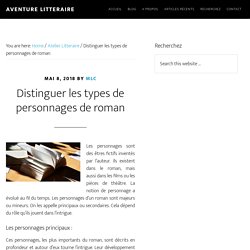
Ils existent dans le roman, mais aussi dans les films ou les pièces de théâtre. La notion de personnage a évolué au fil du temps. Les personnages d’un roman sont majeurs ou mineurs. On les appelle principaux ou secondaires. Cela dépend du rôle qu’ils jouent dans l’intrigue. Les personnages principaux : Ces personnages, les plus importants du roman, sont décrits en profondeur et autour d’eux tourne l’intrigue.
Les deux personnages principaux dans la fiction sont le protagoniste et l’antagoniste. Les personnages secondaires : Ces personnages n’ont pas la même profondeur que les personnages principaux. Photo de stock de Portrait Woman Image Red Indian Neon (modifier maintenant) 511931029. Tumblr. Tumblr. Tumblr. Have a little widdle. Sassy Space Nerd — wodneswynn: kainoliero: wodneswynn: Concept:... Writing Prompts — Ever since you were a child you have had a magical... Sassy Space Nerd — latin phrases worth knowing:
Writing Prompts — The crow visited every day, bringing tiny shiny... Devoutfashion.tumblr. Sink in black to keep head high. Writing Prompts — The protagonist has realized that they are not... Meh. This Bellissimo Son Of A Mama. Writing Tips — blackgirlmagicwrites: Physical flaws to add to... Writing Tips — storypromptsforfun: Why is a Good Guy an... Wafrica, une collection de kimonos traditionnels japonais inspirée de la culture africaine. Sink in black to keep head high. About heroes and monsters. Idea for a short story. Sum astrology explanations. Vampires and history. Magic seen with a Mode angle. Idea for a god. What people do orally. That one post about vampires. Death symbolism. Real unicorns. Tiny dragon and his gold. Emotions hard to explain. Baby dragons. September C. Fawkes, Hiding What the Main Character Knows from the... Mermaid in wheelchairs 4. Mermaid in wheelchairs 3. Mermaid in wheelchairs 2.
Mermaid in wheelchairs 1. Post about adopted kids. Write emotional scene. Faery doctor post to check. Fantasy ideas (ring / wereworlf / highfive) Therapist worksheet. Garden - Schiaparelli f/w 2016-2017 couture. What I've learned about Writing Action Scenes ~ September C. Fawkes. With examples from Fullmetal Alchemist Brotherhood, Pirates of the Caribbean, Lord of the Rings, DBZ, and Die Hard.
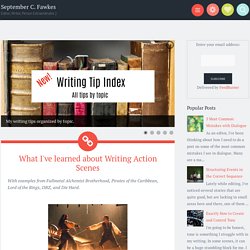
How to Break Writing Rules Right: "Don't Use Adverbs, Adjectives" ~ September C. Fawkes. As I promised last week when I talked about using cliches in your writing, today, I'm talking about using adverbs and adjective in your writing.

When it comes to breaking the rules for adverbs and adjectives, you've got at least five great reasons to do it. 1) The verb or noun you need doesn't exist in your language. 2) To control pacing. 3) To communicate interesting or unusual situations. 4) To create a specific tone or character voice. 5) The adverb or adjective is doing double duty. What's the Rule? The Rule: Don't use adverbs because it weakens your writing. Use adjectives rarely for the same reason. Three Tweaks that Keep Details Interesting ~ September C. Fawkes. Over the last six months or so, I've learned a few new things about writing scenes.

Today, specifically I'm going to share some techniques that can tweak your scene here and there to make it more interesting and to keep it from going stale. They are, expand, deepen, and create motion. As some of you know, I work for David Farland, so his writing tips and lessons obviously have an impact on me, which is why I make sure to mention him right there on the right-hand column of my blog. Well, one of his writing tips led me to come up with the contents of today's post. This is just like a little hypothesis of mine that has developed over the last few months. In one of his writing workshops, Dave talks about how in Hollywood, film makers never want to use the same set twice, if they can help it.
Picking the RIGHT Details ~ September C. Fawkes. If you've been writing very long, you'll know the importance of mentioning details in your writing.
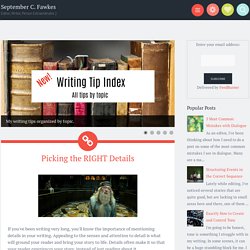
Appealing to the senses and attention to detail is what will ground your reader and bring your story to life. Details often make it so that your reader experiences your story, instead of just reading about it. So as writers, we might want to mention what a character is wearing, the color of her hair, the smell of a river, or the texture of a tent. Usually we want to tag our character's with a particular description. If you read Harry Potter, you'll know the Minister of Magic, Fudge, always has a bowler hat, that Dumbledore has twinkling eyes and half-moon spectacles, that Professor Trelawney wears shawls and smells like sherry. Eric & Louanne (?) Inspi Alice. Inspi Alice ? ou Saad ??? Fox speaking ♡ Infused Water Magic. What Else You Need to Know Most About Character Voice ~ September C. Fawkes. (Listen or watch this writing tip on Youtube) Here's part 2 of my article on character voice.
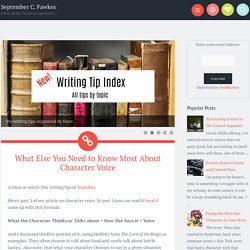
In part 1(you can read it here) I came up with this formula: What the Character Thinks or Talks about + How She Says it = Voice And I discussed the first portion of it, using Hobbits from The Lord of the Rings as examples. What You Need to Know Most About Character Voice ~ September C. Fawkes. (Listen or watch this writing tip on Youtube) I'm kind of embarrassed to admit I didn't have much of an understanding of character voice at the beginning of this year.
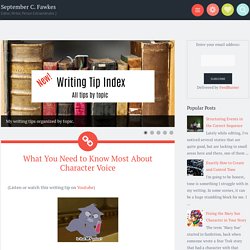
None of my professors in college really talked about it. Relationship as a Character: Crafting Duos, Trios, Groups that Readers can't Resist ~ September C. Fawkes. There are loads of resources about creating great characters.

But when it comes to creating great relationships--the perfect tag team, the favorite couple, the best friends--the writing world is lacking. Whether your characters are romantic partners, coworkers, best friends, siblings or what have you, audiences eat up a wonderfully crafted duo, trio, or group. People love Sherlock and Watson's relationship so much, that there is an entire fan community that roots for them to actually be together. Creating Stunning Side Characters (and Why They Matter) ~ September C. Fawkes. Several years ago I attended a writing workshop at LDStorymakers that was focused entirely on creating side characters.
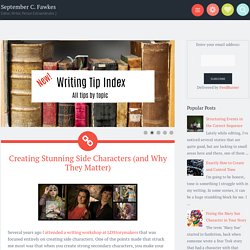
One of the points made that struck me most was that when you create strong secondary characters, you make your novel feel authentic. You make it feel real. This is because as an audience we don't feel as if all the side characters exist for the sake of the main character or the plot. They feel like real people with lives that extend beyond our protagonist. Character Traits that Hike up Tension ~ September C. Fawkes. Weeks ago, I did this post on the difference between tension and conflict.

As a short recap, I mentioned that tension is not necessarily conflict, and I like to think of it as the promise of conflict, that anticipation and worry of what will happen. As writers, we should definitely take advantage at the elements in our plot, world, and (yes) our conflicts to create tension. But over the years I've noticed that some smart writers really hike up the tension of a book through the traits of their viewpoint characters. You see, some traits are natural tension-hikers.
The first time I noticed this was years ago, when reading The Hunger Games. Tension vs. Conflict (Hint: They aren't the Same Thing) ~ September C. Fawkes. I used to think tension and conflict were the same thing. I mean don't they go together? Well, a lot of the time they do, but it's entirely possible to have one without the other. They often go hand-in-hand, but they aren't the same thing. Making Unlikeable People into Likeable Characters ~ September C. Fawkes. Unlikeable people can be a pain to write if they're a main character.
After all, our audience needs to like them enough to be around them for the course of the story. If our readers can't stand them, they won't want to read about them. But sometimes our protagonists are meant to be bad. 15+ Tactics for Writing Humor ~ September C. Fawkes. A monster-length master list of over 15 tactics for writing humor, with examples from The Office, Trigun, Diary of a Wimpy Kid, Emperor's New Groove, The Fault in Our Stars, Harry Potter, Pink Panther, The Series of Unfortunate Events, Elf, Enchanted, The Amazing Spider-man, and more. Be prepared to laugh. Introduction. Writing Tips — Writing Tip Index. Angelsocialist: genehiss: depression apathy is... - Weeaboo. Theticklishpear: Table of Contents Part One: A... Writing Tips — 20 things I want more of in fiction: strong female... Le pouvoir de l'amitié. Supervillains make things change. Character creation masterpost. 5 traits of a likeable hero. I used to have a theme. — geisha are absolutely not prostitutes btw.
HASHTAG NINJA. Harmony Ink Press. Veery Thrush. Artisanat Equateur. Il serait bien trop long ici de référencer tout ce que peut proposer l'Equateur et son artisanat!! Nous ne parlerons que de quelques spécialités parfois connues du grand public internationnal. En Equateur, chaque région, pour ne pas dire chaque ville à sa propre spécificité artisanale, qu'elle a acquerit et transmise depuis des siècles.
Bien compliqué alors de faire l'état des lieux détaillé. Things I Love to See: Full-Time Tsukishima-Apologist. Writing Tips — hey there! thanks for answering all our questions... Longlivefise: deonsraw: gottalovesteak: ... - Weeaboo. Meh. / know the difference. Arts aztèque. L'art des Aztèques, comme leur religion, est le résultat d'une synthèse. La tradition toltèque qui avait survécu dans certaines villes du plateau central comme Culhuacàn, le style « mixtéca-puebla » de Cholula, de Tizatlàn et de l'Oaxaca, et certaines influences d'origine plus lointaine, comme celle des Huaxtèques, se sont amalgamés en un ensemble original.
. Jaguar et Aigle dans la mythologie amérindienne - Symbolisme du jaguar en Méso-Amérique Le jaguar était vénéré par les Aztèques mais ce respect pour cet animal a des racines bien plus anciennes en Méso-Amérique. Cosplay Blog. Meh. Clevergirlhelps. Protheangel: blueberry32: hawkeyedflame: ... - What a Fye life ! Don't be such a boob punch.
Pruningthemindsgarden: bounemr: Okay but we... - Weeaboo. Writing Tips — Negative Speaking Tones. a2nyc - ‘She’s a woman of uncanny powers,’ said Robinson,... Currently in a mood. M A N I A. Writing Tips — Writer’s Scene Checklist. Writing Tips — Tips On How to Write Characters with Wings (For... Clevergirlhelps. 25 Things You Should Know About Writing Horror. I grew up on horror fiction. Used to eat it up with a spoon. These days, not so much, but only I suspect because the horror releases just aren’t coming as fast and furious as they once did. But really, the novels I have coming out so far are all, in their own way, horror novels. DOUBLE DEAD takes place in a zombie-fucked America with its protagonist being a genuinely monstrous vampire.
BLACKBIRDS and MOCKINGBIRD feature a girl who can touch you and see how and when you’re going to die and then presents her with very few ways to do anything about it. And so it feels like a good time — with Halloween approaching, with DOUBLE DEAD in November and me writing MOCKINGBIRD at present — to visit the subject of writing horror. None of this is meant to be hard and firm in terms of providing answers and advice.
Peruse it. 1. Every story is, in its tiny way, a horror story. Clevergirlhelps. #DRAWINGS AND FEELS, gluklixhe: ironbite4: fluffmugger: ... Writing Prompts — Magic exists, but it is provided by large... Friendly Local Cryptid — How to deal with street cats. Meh.